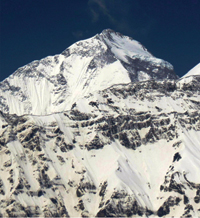Ever been to Himavat? Of course you have - it’s an older, alternative name for the Himalayas. Reading and writing about Nepal requires understanding mountain words. So does trekking, for the guidebooks and maps are littered with mountain terms. I’ve always thought how much more enriched and rewarding travel in high Nepal would be if trekkers (especially foreigners) knew more place names and their meaning.
For starters, here are a few mountain area terms commonly found on maps, and a few others, with their sources and meanings (their mul and matlab, that is).
 Himal, Himala, Himalchal, Himalaya: Over a century ago the British colonial wordsmiths Henry Yule and A.C. Burnell wrote in the Hobson-Jobson dictionary that the Himal is “properly Himālăya, ‘the Abode of Snow’; also called Himavat, ‘the Snowy’; Himagiri and Himaśaila; Himādri, Himakūta, &c....” They attribute the first use of the modern term ‘Himalaya’ (in English writing) to Reginald Heber (1783-1826), the Church of England’s Bishop of Calcutta. It appears in his Indian Journal, published posthumously in 1828.
Himal, Himala, Himalchal, Himalaya: Over a century ago the British colonial wordsmiths Henry Yule and A.C. Burnell wrote in the Hobson-Jobson dictionary that the Himal is “properly Himālăya, ‘the Abode of Snow’; also called Himavat, ‘the Snowy’; Himagiri and Himaśaila; Himādri, Himakūta, &c....” They attribute the first use of the modern term ‘Himalaya’ (in English writing) to Reginald Heber (1783-1826), the Church of England’s Bishop of Calcutta. It appears in his Indian Journal, published posthumously in 1828.
The 14 highest Himalayan peaks, all above 8,000 meters, are listed here in order of their height. Several of them straddle international borders and eight are all or partly in Nepal (in bold): Everest, K2, Kangchenjunga, Lhotse, Makalu, Cho Oyu, Dhaulagiri, Manaslu, Nanga Parbat, Annapurna, Gasherbrum-I, Broad Peak, Gasherbrum-II, and Shishapangma. Some names have special meaning. Kanchenjunga is the ‘Five Treasures of Snow’ (in Tibetan). Cho Oyu is the ‘Turquoise God’ (Tib.). Dhaulagiri is the ‘White Mountain’ (Sanskrit). Manaslu is ‘Mountain of the Spirit’ (Skt.). Nanga Parbat is the ‘Naked Mountain’ (Urdu). Annapurna is the ‘Goddess of Harvest’ (Skt.). Gasherbrum is the ‘Beautiful Mountain’ (Balti). And Shishapangma viewed from the north looks like a ‘Crest above the Grassy Plains’ (Tib.), but it is also a ‘Holy Place’ known to the Nepalese as Gosainthan.
The root ‘him’ in Himal/Himalaya is derived from hiun (hiũ), meaning ‘snow’. Himmat, ‘courage’, comes from it, so that ‘himmat bandhnu’ means ‘to be of good courage’ - necessary if you want to trek high or climb a peak. ‘Himmat’ is also used as a man’s name.
The suffix -giri, as in Dhaulagiri, is a Sanskrit term meaning ‘mountain’. It also occurs in Nilgiri, the name for three icey ‘Blue Mountain’ peaks that rise high in the east over Jomsom, in Thak Khola, Mustang District.
Lower down, many of the foothills are of mountainous size. The midhills are the ‘Pahar’, meaning a ‘hill’ or ‘mountain’ area, and one who dwells there is a ‘Pahari’. The hill areas that butt up directly against the Himalayas are the ‘Lek’, and their inhabitants are called ‘Lekhali’. It is often said in Nepali that the mountainous Lek is far off in durgam chhetra, denoting a remote area or (holy) place. In common usage it implies a difficult locale where only the most robust mountain people live.
The high Lek has many sheep/goat, cattle and yak grazing lands, called kharka, literally ‘pasture’ or ‘meadow’. There are numerous named kharkas on trekkers’ maps. If you arrive at one during the summer grazing season you are likely to find one or more shepherd huts called ‘goth’ (rhymes with boat), and some gothalos (shepherds). You’ll also be confronted by livestock guardian dogs (kukur), the largest of which are the famous ‘Bhoté kukur’ (Tibetan mastiffs).
Many a hilltop or ridge is called ‘danda’, such as Bahun Danda, ‘Brahmin Hill’, in northern Lamjung District of central Nepal, on the old trail to Manang. And a place to worship the mountain goddess is a ‘deorali’, usually on or near a ‘bhanjhyang’, a pass over a danda. The highest mountain passes are usually called ‘la’ (Tib.), as in Thorung La on the popular Round Annapurna circuit trail.
This is a small sampling of mountain of terms from the Nepal Himalayas. Now take to the trail and enjoy your trek!
Note that Nepali terms are spelled many different ways on maps and in guidebooks. Yule and Burnell’s classic ‘Hobson-Jobson: A Glossary of Colloquial Anglo-Indian Words and Phrases, and of Kindred Terms, Etymological, Historical, Geographical and Discursive’ was first published in 1886 and updated in 1903. There are reprint editions, but original copies of both versions are collectors’ items. The ‘Hobson-Jobson’ is a fascinating sourcebook with over 2,000 entries, including etymological citations that date to some of the earliest literary sources from the first European contacts with South Asia. Two dictionaries used for this essay are R.L. Turner’s ‘A Comparative and Etymological Dictionary of the Nepali Language’ (1931), and R.L. Schmidt’s ‘A Practical Dictionary of Modern Nepali’ (1994). All three of these dictionaries (and others) are accessible online at dsal.uchicago.edu/dictionaries.
The author is a regular contributor to ECS Nepal magazine, and can be contacted at don.editor@gmail.com.











